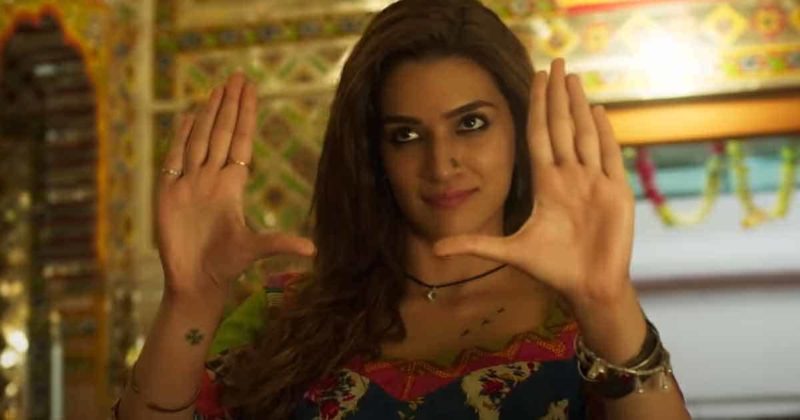Winner of the 58th National Film Award for Best Feature Film in Marathi, ‘Mala Aai Vhhaychy!’ (2011) was the poignant tale of a surrogate mother who bears the child of a couple from America. Two years after its release, the much successful Marathi film was remade in Telugu as ‘Welcome Obama’. It took a decade for the film to be remade in Hindi as ‘Mimi’. Directed by Laxman Utekar, who had earlier helmed ‘Luka Chuppi’ (2019), the film stars Kriti Sanon in the titular role.
Though Mimi Rathore (Kriti Sanon) lives in a small, conservative city in Rajasthan, she harbours the dream of becoming a Hindi film heroine. Mimi is quite popular as a dancer in her hometown. She does dance based shows in some of the venues in the small city and hopes that with the money she saves, she will be able to shift to Mumbai someday soon to pursue her dreams. Summer (Evelyn Edwards) and John (Aidan Whytock) are a young couple from America who are looking for a ‘fit and healthy’ woman who could be the ideal surrogate mother to the child they hope to have. A driver named Bhanu (Pankaj Tripathi) comes on board to help them in this task in exchange of money. When the couple tells him that Mimi is exactly like the kind of woman they have been looking for, Bhanu takes up the onus to convince Mimi to conceive their child for them. What Mimi would get in return is a large sum of money that would help her realise her Bollywood dreams.
The original Marathi film, which ‘Mimi’ is based on, was designed as a serious social drama. Laxman Utekar and Rohan Shankar, who have adapted the original source material written by Samrouddhi Porey, have taken some of the important plot points from the film but have written a screenplay that is starkly different from that of the original. Humour, for instance, was sparsely used in the original film. Here, humour plays an important part throughout the narrative. The humour in the original film was the kind that might not have worked today.
In the original film, the central character (Yashoda; played by Urmila Kanetkar) was shown to be a subdued person who was burdened by the tough times she went through in her past and the responsibilities she has to shoulder in the present. In ‘Mimi’, the central character is shown to be a feisty woman who speaks her mind and follows her heart. The protagonists of the two films are as different as chalk and cheese. ‘Mala Aai Vhhaychy!’ was set in a village but ‘Mimi’ is based in a city that has some modern amenities but is largely occupied by people who belief in traditional values. The remake is, arguably, more colourful and despite the similar length, has a much faster pace to it than the original. In India, the laws governing surrogacy practices have undergone several changes in the last couple of years and perhaps, that’s the reason ‘Mimi’ is set in 2013 and not 2020 or 2021.
Now, that we have compared the two films, let’s evaluate the strengths and weaknesses of ‘Mimi’ as a standalone film. First things first, ‘Mimi’ is the best feature-length Hindi film to have released in a long time. The film works very well as a social drama and uses humour in the right measure to ensure the audience never loses interest in the narrative. The writers get the nuances of the small city (and not town) the film is based in right and that’s one of the strengths of the film. The screenplay is water-tight and is largely deprived of any dull moment. The dialogues (Rohan Shankar) are sharp and witty and contribute significantly towards making the audience laugh and keeping them hooked to the narrative.
Cinematographer turned filmmaker Laxman Utekar gave a good account of himself in ‘Luka Chuppi’, his first film as a director. With ‘Mimi’, he takes giant strides as a filmmaker and his growth as a storyteller is there to be seen. He handles the dramatic moments with a lot of sensitivity and ensures that the scenes, which are laced with humour, land well. The bright and vibrant camerawork (Akash Agrawal) complements the mood and milieu of the film very well. The songs (A R Rahman) gel well with the narrative of the film but do not have much recall value. ‘Param Sundari’ makes an impact largely because of the way it has been picturised, choreographed (Ganesh Acharya) and performed. The background score (A R Rahman) is decent. The production design (Subrata Chakraborty and Amit Ray) is very impressive.
The film rests on Kriti Sanon’s able shoulders and she delivers a knock-out performance. Along with ‘Raabta’, ‘Bareilly Ki Barfi’ and ‘Luka Chuppi’, this ranks as one of her best performances so far. She gets the diction and brings Mimi’s unbridled energy to the screen fabulously. Her transition from being a young woman with dreams in her eyes to someone who embraces motherhood comes across very well. Pankaj Tripathi delivers an earnest performance, as always. It’s good to see him playing a character that is close to his real age, for a change. Sai Tamhankar underplays her character beautifully and leaves a huge impact as Shama. Manoj Pahwa performs very well but one feels his character remained a little under-cooked. Supriya Pathak gets some good scenes to chew on especially with Kriti. Jaya Bhattacharya leaves a mark in a cameo. Evelyn Edwards and Aidan Whytock are good as the foreigner couple. They get some moments to shine towards the end of the second half and they perform well. Jacob Smith, as Raj, delivers a cutesy performance but the fact that his Hindi lines have been dubbed by another artist is too obvious.
‘Mimi’ delivers an important social message and offers great entertainment value at the same time. Led by strong performances and a consistently engaging screenplay, this film is well worth your time.

